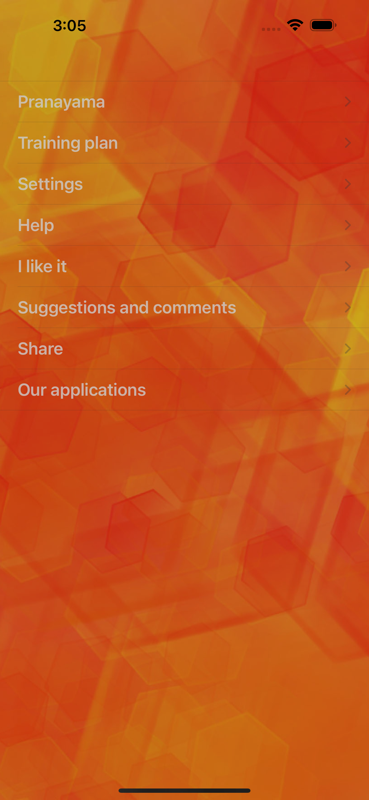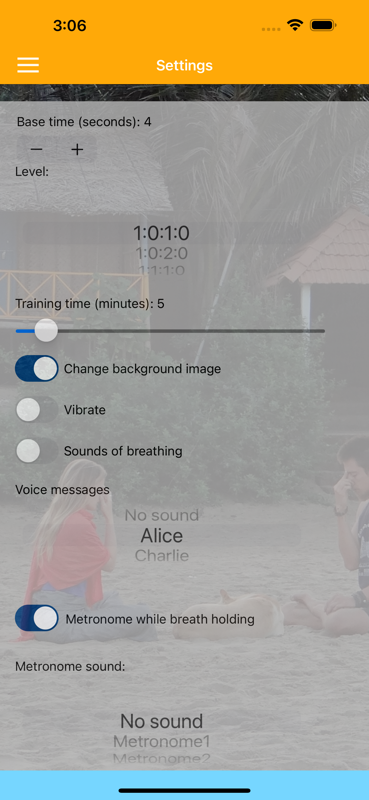About the Pranayama Breathing Yoga Timer App
With the help of this app you will be able to manage easily time measurement while performing the Anuloma Viloma Yoga breathing system (with the change of your nasal holes). In contrast to other apps, our app ensures a gradual and safe progress if the performing of the Anuloma Viloma technique is correct. You progress gradually in 15 levels of practice to the best recommended by the classical yoga breathing level (inhalation: breath holding: exhalation: breath holding).
App Features
15 levels of mastering Anuloma Viloma (inhalation: breath holding: exhalation: breath holding):
- 1: 0: 1: 0 (inhalation is equal to exhalation, without breath holding);
- 1: 0: 2: 0 (exhalation is twice longer than inhalation, without breath holding);
- 1: 1: 1: 0 (inhalation is equal to breath holding as well as exhalation, without breath holding after exhalation).
Then the exhalation follows twice as long as the inhalation, the breath holding increases gradually.
1: 1: 2: 0, 1: 2: 2: 0, 1: 3: 2: 0, 1: 4: 2: 0.
You can set the duration of the inhalation phase from 4 to 40 seconds to improve within the level to be mastered.
The app allows you to set the duration of the training from 5 to 60 minutes. There are several timing modes during this exercise, which can be combined with each other. The onset of inhalation, breath holding and exhalation are indicated by vibration, human voice or breathing sounds. In addition, you can choose either metronome sounds or surfing sound, your sound from media library. The adjustment to the training ensures the appropriate background images, which you can choose for your screen.
Benefit from the regular Anuloma Viloma exercise:
- the nervous system calms down;
- the tonus of the right and left hemispheres of the brain is balanced;
- the vital lung volume increases;
- the immune system is strengthened;
- the mind is resting;
- there are feelings of lightness, strength, balance, relaxation, stability, self-confidence and clear thinking;
- tension, negative emotions and headaches disappear;
- in addition, the immobility of the posture and the breath holding almost inevitably lead to the halting of the mental activity, which is the primary goal of yoga.
How to increase the breath holding
The occurrence of discomfort, exertion, symptoms such as dyspnoea, dizziness, nausea, feeling of pulsation in the head, heart palpitations etc. mean that the chosen duration of the breath holding is premature, therefore it does not work well. The duration of the breath holding is strictly determined individually and at the present time for a specific person: also within the personal experience of a person the limits of the comfortable breath holding change from day to day. Always remember that the dyspnea and the desire to catch your breath after the end of the breathing exercise indicate an excess of abilities. This is undesirable.
According to the Bihar School of Yoga Sivananda-Satyananda, the following procedure is proposed to achieve the positive effects of the Anuloma Viloma exercise.
- Start the exercise with the ratio of 1: 0: 1: 0. After several cycles of alternative breathing calculate the duration of your comfortable inhalation. Then you have to practice it a few times while you are paying careful attention to the tension — there should be none. Thus, the duration of inhalation for the training is calculated, it is usually 5 or 7 seconds. Practice each day (for example, inhale 5 seconds and exhale 5 seconds) until the total training time is brought to 10-15 minutes.
- Now increase the duration of inhalation by one second. Repeat the scheme 1: 0: 1: 0 until the total training time is brought to 10-15 minutes. This continues until you are comfortable at the 1: 0: 1: 0 level with the duration of inhalation of 10 seconds.
- Go to the next level of 1: 0: 2: 0. The duration of inhalation is reduced by half or more, i.e. the inhalation takes 5 or 4 seconds. The level of 1: 0: 2: 0 already has strong influence on the psyche, you get strong introversion, you dive into yourself.
- Then increase the duration of inhalation by one second. Exercise the scheme of 1: 0: 2: 0 until the total training time is brought to 10-15 minutes. This continues until you are comfortable at the level of 1: 0: 2: 0, with the duration of inhalation 10 seconds.
- Then go to the level of 1: 1: 1: 0, when you begin to hold your breath. The breathing should be quiet, silent, comfortable and the whole time conscience. The inhalation duration is reduced by half or more. The purpose of this level is relaxed breathing in the ratio 1: 0: 2: 0 with the inhalation duration of 10 seconds during 10-15 minutes.
- By repeating the above process you reach the classic level of 1: 4: 2: 0 with the duration of inhalation 10 seconds during 10-15 minutes.
Breathe during the breathing exercises Anuloma Viloma completes yoga breathing. This is breathing through the nose with the use of ventral, middle and upper type of breathing. Breathe slowly and consciously in and out. Feel how the air moves. Keep the ratio of breathing and the duration of inhalation constant during an Anuloma Viloma exercise because the variety in the training maintains the mind in a short period of time and contributes to the arousal (not the calming) of the nervous system.
IMPORTANT!
After breath holding keep on an inhalation the tension in your chest during the entire breath holding.
Keep your throat closed during breath holding. To achieve this, pull the cervical curvature of the spine upwards, then pull the head slightly back, and then gently pull the chin to your neck, to the hollow between the bones on the chest. The muscles of your neck and throat should remain at rest. Thanks to the displacement in the relative positions of the chin and chest the desired tension is produced. Before beginning exhalation, release the lock in the throat and breathe out. This will protect you from increased brain pressure and dizziness.
Description of the technique Anuloma Viloma with breath holding
Pranayama is practiced three times a day on an empty stomach: in the morning after waking up before breakfast, at midday after a cycle of asanas and in the evening before falling asleep. Or at any time of the day, but only 2-3 hours following a meal.
You should practice quietly in a secluded quiet clean warm and well ventilated room or outdoors.
Turn off the communications, computer, TV and other equipment that can hinder you.
Perform exercises better sitting in a comfortable position with a straight back perpendicular to the floor. You can also stand, your shoulders should be relaxed.
It is permissible to use a meditation pad. You can also use a usual chair, but the back should be straight and the feet should be fixed on the floor shoulder width apart.
Do not lean against the wall or the chair back. Pull your pelvis vertically to keep a small inflection in the cross. Stretch your shoulders. A small pillow (a hard pillow, a "brick", a folded blanket) under the basin is used in sitting positions.
During the training you should not feel tension in facial muscles, eyes, ears, muscles of the neck, shoulders, arms, hips and feet. Relax hips and arms intentionally as they are unconsciously tensed during Pranayama.
There should be no oxygen deficiency (no sense of lack of oxygen)! Breathing should ideally be inaudible or soundless.
When inhaling, the abdominal cavity should increase in volume, so do not strain your stomach too much.
Breathe in deeply three times preliminarily. Bring your hand to your face on the third exhalation. Close the right nostril with your thumb and breathe in through the left nostril. Connect the middle and the pointing fingers and fix them for the whole time of the exercise at the point between the eyebrows. Close the right nostril with your thumb and the left with the ring and little finger. Ensure uniform pressure on the nostrils. No pressure should be felt inside the ears. The shoulders should be relaxed. Hold your breath. The hand closing your nose is perpendicular to the floor and close to the body to relieve the hand tension.
Take the thumb from the right nostril. Breathe out slowly. In the last second the lung should be absolutely empty. Now breathe in right. The hand position is similar, with gentle pressure on the left nostril with the ring and small finger. Breathe in, fill your lungs with air. Repeat breath holding and breathe out. Focus on the sensations in the nostrils. Feel the cool air get up through the nasal passage while inhaling and then the warm air get down while exhaling. This is a cycle. Practice this way until the end of the set time.
Be attentive to your well-being, be modest and humble in your breathing exercise, increase the strain slowly. And you will surely achieve the desired results.
P. S. If you want the app to use a different language, or if you want to change your current translation, if you have any feedback for future versions of the app, please write to the author: ole-gin@yandex.ru
If you are satisfied with this app and you want it to be further developed, do not forget to give your positive rating on the App Store. ☺ Thanks!
We recommend our apps in App Store Apnea Tables Trainer and EvoParameter — Workout Diary.





